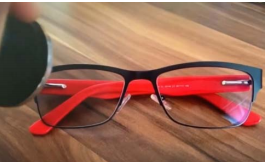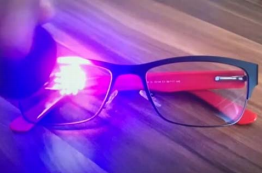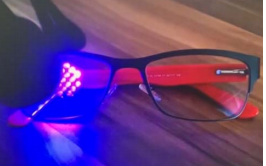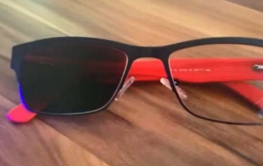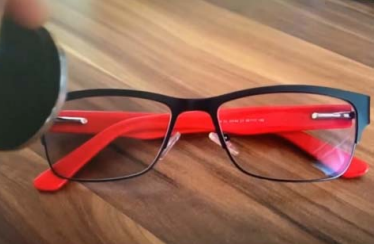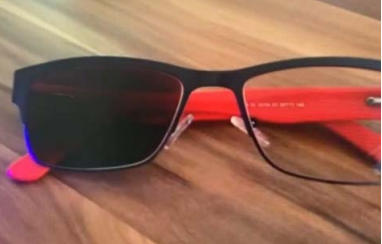Photochromic lens
- What photochromic lens is?
-Someone called Photochromic lens as Photosensitive lenses. When exposed to strong light, letting the original transparent and colorless lenses will become colored lenses for protection, so they are suitable for both indoor and outdoor use. According to the principle of the reversible reaction between light and color, the photochromic lens can quickly darken under sunlight and ultraviolet rays, block the strong light and absorb ultraviolet rays, and have a neutral absorption of visible light. back to the dark place, it can quickly restore colorless and transparent, ensuring the lens Light transmittance. Therefore, the photochromic lens is suitable for indoor and outdoor use at the same time to prevent the sun, ultraviolet light, and glare from harming the eyes.
-The photochromic lens is mainly used in the open-air place, snowy place, and indoor workplaces with strong light sources, prevent the sun, ultraviolet light, and glare from harming the eyes. The response of the photochromic lens to light is affected by temperature. The decrease in temperature will change the “vitality” of the photochromic reaction so that the composite reaction and the reaction of the lens to restore light transmission slows down and delays the color change time. Therefore, in a low-temperature environment, the color change glasses will be irradiated by light, the color change will be relatively large and appear darker.
2.Classification and principle of photochromic lenses
According to the different positions of the lens, the photochromic lens can be divided into two types: base color lens (referred to as “base change”) and coating lens (referred to as “coating change”).
*Base changes lens: silver halide chemical substances are added to the lens substrate, and the silver halide ion reaction is used to decompose into silver and halogen under strong light stimulation so that the lens is colored, when light is weakened, it will be combined into halogen Silver, the color becomes lighter. This kind of technology is often used for glass photochromic lenses.
* Coating changes lens: special treatment is carried out in the lens coating process. For example, spiropyran compounds are used for high-speed spin coating on the surface of the lens. According to the intensity of light and ultraviolet rays, the molecular structure itself can be opened and closed to achieve the effect of passing or blocking light.

3.Features of photochromic lenses
– The speed of discoloration
is an important reference factor for the purchase of photochromic lenses. The faster the discoloration speed of the lens the better is. For instance, from a dark room to a bright outdoor room. The discoloration speed is faster. it is more to prevent the damage of the strong light/ultraviolet rays to the eyes in time. Generally speaking, the coating technology is faster than the substrate color-changing technology. For example, the new coating technology, the photochromic factor uses spiropyran compounds, which have better light responsiveness, and uses the inverted opening and closing of the molecular structure itself to achieve the effect of passing or blocking light, so changing color is faster.
-Discoloration uniformity
refers to the uniformity of the color of the lens during the process of changing the color of the lens from light to dark or from dark to light. The more uniform the discoloration, the better the photochromic lens. In the traditional base lens, the photochromic factor is on the lens substrate, and the color change effect will be affected by the thickness of different areas of the lens. Because the center of the lens is thin and the periphery is thick, the center area of the lens discolors more slowly than the periphery, and the panda eye effect will appear. The coating lens uses high-speed spin coating technology, and the color-changing layer is uniformly spin-coated to make the color more uniform after the color change.
-Service life
Generally, the service life of photochromic lenses is about 1-2 years, but many companies are looking for ways to extend the service life of photochromic lenses.
After spin-coating the color-changing layer, the lens will also undergo an intensified coating treatment. Also, the color-changing substance used-the spiropyran compound itself has good light stability, and the color-changing function is maintained for a longer time, basically up to two years and above.
4.Choice of photochromic lenses
When choosing glasses with photochromic lenses, it is mainly considered from the functional characteristics of the lenses, the purpose of the glasses, and personal requirements for colors. Photochromic lenses can also be made Variety of colors, such as gray, brown, etc.
- Gray lens: It can absorb infrared rays and 98% of ultraviolet rays. The biggest advantage of the gray lens is that it will not change the original color of the scene due to the lens, and the biggest satisfaction is that it can very effectively reduce the light intensity. The gray lens can absorb any color spectrum evenly, so the scene will only become darker, but there will be no obvious chromatic aberration, showing a real and natural feeling. It belongs to the neutral color system, which is suitable for all people.
- Pink lenses: This is a very common color. It can absorb 95% of ultraviolet rays. If it is used to correct eyesight for women who must wear them often should choose light red lenses. because light red lenses absorb ultraviolet rays better and can reduce the overall light intensity, so the wearer will feel more comfortable.
- Light purple lenses: Like pink lenses, because of their relatively darker color, they are more popular with mature women.
- Brown lenses: It can absorb 100% of ultraviolet rays, the brown lens can filter out a lot of blue light, meanwhile improve the visual contrast and clarity, so it is very popular with wearers. Especially when the air pollution is serious or foggy, the wearing effect is better. Generally, it can block the reflected light from a smooth and shiny surface, and the wearer can still see the subtle parts. It is an ideal choice for drivers. For middle-aged and elderly patients with high vision above 600 degrees, priority can be given.
- Light blue lenses: Sunglasses with blue lenses can be worn when playing on the beach by the sea. The blue color can effectively filter out the light blue reflected by the sea and the sky. We should avoid using blue lenses when driving because it will make us unable to distinguish the color of the traffic signal.
- Green lens: Green lenses can be the same as gray lenses, which can effectively absorb infrared light and 99% ultraviolet light. While absorbing light, it maximizes the green light reaching the eyes, so it has a cool and comfortable feeling, suitable for people who are prone to eye fatigue.
- Yellow lens: It can absorb 100% of ultraviolet rays, and allows infrared rays and 83% of visible light to penetrate the lens. The biggest feature of yellow lenses is that they absorb most of the blue light.
- Precautions for color changing mirrors
- If you go inside and outside with glasses frequently, the discoloration effect is not good, because your pupils will also change with the color of the lens, which increases the burden on your eyes and is prone to visual fatigue.
- The fading speed of photochromic glasses is slow. When entering a dark light environment from a bright light environment, there may be transient darkness.
- The light transmittance of photochromic myopia glasses is not as good as that of ordinary myopia glasses. If you have glaucoma, high myopia, and hyperopia, it is not recommended to use photochromic glasses for myopia.
- For people with deep nearsightedness and farsightedness, it is best to use light white lenses when using spectacle lenses. The inconsistent shades of the color mirror will affect the blur and clear vision. Therefore, people with deep myopia or high-aspect-ratio hyperopia are not suitable for wearing photochromic glasses.
6.Quality identification of photochromic lenses
- The two lenses of the photochromic glasses must be the same color without any difference. The color change must be uniform, and it cannot show several colors. There is a no different color. The high-quality photochromic lens change color is fast when sees sunlight, also fade is fast without sunlight. Inferior lenses change color slowly and fade quickly, or change color quickly and fade slowly. The worst photochromic glasses do not change color at all.
- The thickness of the two lenses of the photochromic lens should be the same, it can not one thick and the other is thin, otherwise, it will affect the vision and damage the health of the eyes. The thickness of the single-lens should also be uniform. If it is a photochromic lens, the thickness should be about 2mm, and the edges should be smooth.
- There is no sensation when wearing, no dizziness or swelling, no blur or deformation of the observed object. When buying, hold the glasses, see through the lens with one eye, and shake the lens up and down, so that the distant objects should not have the illusion of movement.
- Fast discoloration speed: high-quality photochromic glasses can respond quickly to the environment. Put the glasses in sunlight. the maximum color depth should be reached within 10 minutes of exposure to sunlight, otherwise, the color will change low quality. Move the glasses that have been discolored under the fluorescent lamp to a dark place, and the lens should not exceed 20 minutes for the rejuvenation time to be a high-quality photochromic lens.
- Protective, high-quality photochromic glasses can block 100% of ultraviolet A and ultraviolet B, which is recommended for wearers Provides the most effective UV protection.
7.Recognition and inspection of photochromic glasses
photochromic lens recognition: light-sensing, one glasses with two colors lenses.
Simulate ultraviolet light (UV lamp) irradiation–>Turn on the light source–>Irradiate from different angles–>Check if the lens is discolored.
Inspect photochromic lenses and whether have change colors function.
* Discoloration speed of the lens
*After ultraviolet (sunlight) exposure, how long can the color change completely by observation, and how long will the color fade and reach translucency after leaving the ultraviolet radiation at normal temperature, that is, the time when the lens is lightened when it is moved to a low-light environment. Generally, it can be restored to its original state within 20 minutes. after the lens is completely faded, check whether the surface of the lens is colorless and transparent without leaving any color.
Discoloration inspection judgment:
- After being irradiated by ultraviolet rays, sunlight, or UV lamps, the lens appears to be completely discolored. if it was no discoloration or incomplete discoloration is unqualified.
- After leaving the ultraviolet, sunlight, or UV lamp, the color fades gradually under normal temperature and low light environment, and the original transparency is reached within 20 minutes, which is qualified. If the color does not fade or the fade time exceeds 20 minutes, it is unqualified.
- For the discoloration surface, when inspecting the discoloration lens, the outer side of the lens (not the side close to the eye) is irradiated with a UV lamp, and the inner side of the lens is not discolored as qualified, otherwise it is unqualified.



